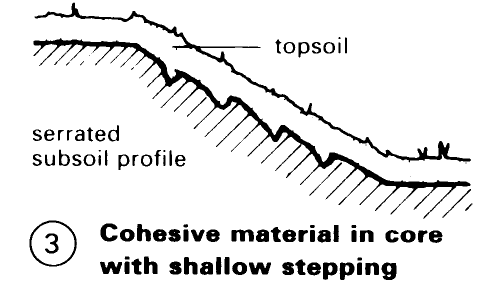Pergolas, Paths, Steps, Retaining Walls. Earthwork
Prefabricated paving slabs are ideal for creating solid and easily maintained garden paths between beds – (4). Paving stones can be laid in the borders or the lawn, either raised or flush with the surface – (5) – (7). Allow for a gradient when laying paths – (10) – (12).



Examples (13) – (24) show various arrangements for garden steps. They should be safe and easy to use (note that a concave gradient is more comfortable to walk on – (8) + (9)) but should also fit harmoniously into the surroundings. The steps should slope gently forwards to permit rainwater to run off. In gardens that are designed to be as close as possible to a natural state, log steps are a worthy solution – (13) + (19). Whatever type of garden steps are chosen, the same rules as apply to indoor stairs should be taken into account.


It is possible to incorporate ramps in the garden steps to facilitate movement of bicycles, prams and roller waste bins – (25). Wheelchairs being pushed by carers can also make use of such ramps.

Layered dry stone construction can be used for retaining walls up to 2 m high in front of uncultivated earth, with an inclination to the slope of 5-20% - (26). However, concrete retaining walls – (27) are simpler and cheaper, and can be bought as ready-made sections – (28) in various sizes and shapes such as corner profiles, quarter segment profiles and round sections, making it possible to form bends with standard parts.

Earthwork. Topsoil can be stored on site by temporarily removing it and building soil mounds - (1). If it is not in the shade, the top of the mound should be protected (with turf, straw etc.) to prevent excessive drying out. Topsoil mounds should be turned over at least once per year, and 0.5kg of quicklime added per cubic metre. If the topsoil needs to be stored for very lengthy periods, consider sowing plants on the mound.

When making up the ground again after the earthworks are completed, compaction measures are necessary if landscaping, lawn laying or planting work is to be carried out immediately, and especially if the work involves laying paths and paved areas. The following techniques can be considered.
- Rolling using a tracked vehicle (e.g. bulldozer) usually provides sufficient compaction for each layer of fill.
- Soaking can be used, but only if the filling material is good (sand and gravel).
- Rolling with a drum roller to compact stable soil in layers (fill height 30-40cm per layer) is another option. Note that it is important always to roll from outside towards the centre (i.e. from the slope towards the centre of the built-up surface). Use rolling for broken stone hardcore when building roads and paths.
- Tamping or ramming is possible on all stable soils.
- Vibration can be used in the case of loose, nonbinding materials.
All compaction should take account of subsequent work. For paths and paved areas compaction is needed up to and including the top layer while lawns require 10cm of loose topsoil, and planted areas 40cm.
Slope protection. To avoid slippage and erosion by wind, water run-off etc. the filling on slopes should be laid in layers. Serrated subsoil profiles (2) prevent the loose infill mass from forming a slip plane on the base material. In the case of higher banks with steeper slopes - (3), stepping provides an effective means of preventing slippage (step width >50cm). If steps are inclined into the slope a longitudinal gradient must be created to allow any build up of water to run away.


Date added: 2023-01-05; views: 549;
